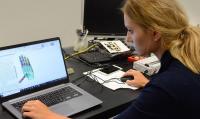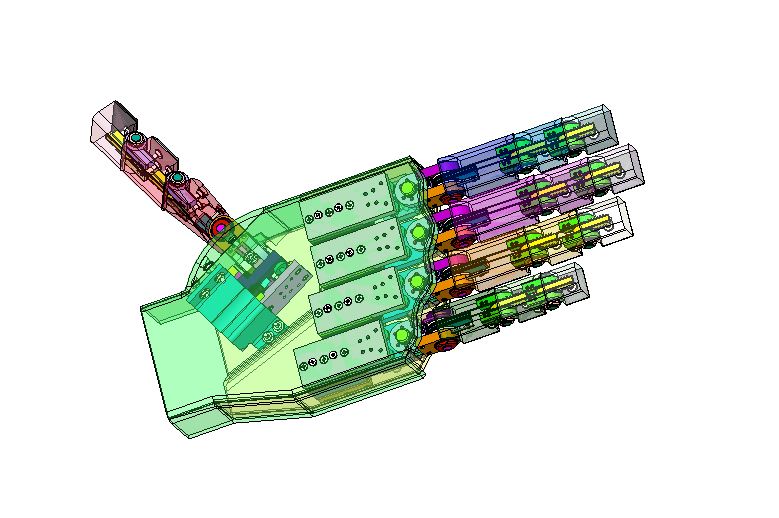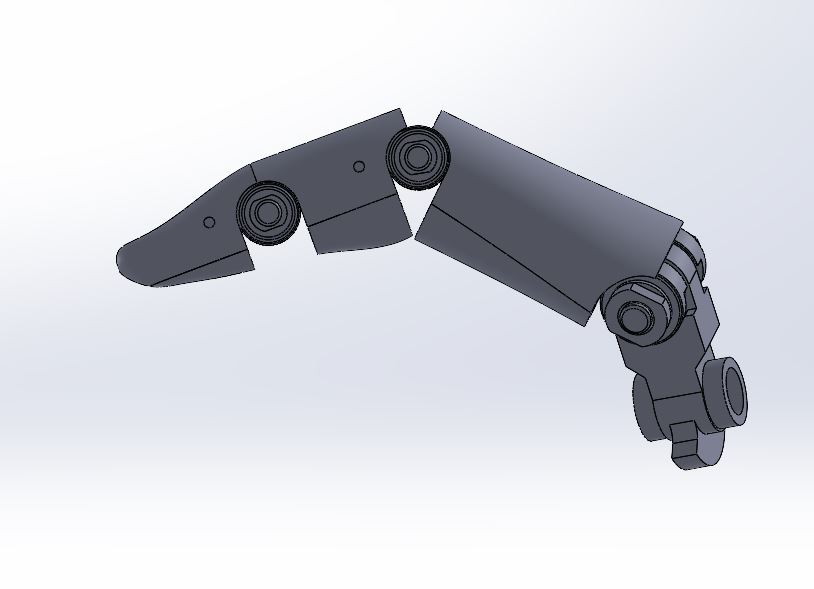Work in progress on a modular hand prosthesis at WUT
Each year, around 185 thousand people worldwide undergo amputation. It is estimated that this number will double by 2050. A team from the Warsaw University of Technology is working on a universal and cheap hand prosthesis, the elements of which would be replaceable and could "grow" with the user.
Ewelina Drelich, a graduate of engineering studies at the Faculty of Power and Aeronautical Engineering, and currently a student of the Faculty of Electronics and Information Technology, came up with the idea of creating a modular hand prosthesis. Where did the inspiration come from?
Childhood dreams
– Ever since I was a child, I dreamed of being a doctor. Unfortunately, I am very much afraid of blood. I decided that it was not a good idea, because I would faint in front of a patient every time – Ewelina Drelich laughs.
Nonetheless, the student found a way to help people. She started studying at the Faculty of Power and Aeronautical Engineering in the field of automation and robotics, specializing in biomechanics and bio-robotics. When looking for a topic for an engineering thesis, she considered making a small humanoid robot. However, it turned out to be too big of a project. She decided to concentrate on its part - a hand.
– I figured that creating a hand prosthesis will be a great alternative. Thanks to this, I can help people with a real problem – hand amputation, combining it with my passion for technology – she says.
The main goal of my work was to create the basis of the prosthesis mechanism, which in the future could be used to build a "universal" prosthesis, i.e. that could cheaply - by replacing appropriate skeletal elements "grow" with a person. One of the key design assumptions was also the "closure" of the prosthetic mechanism, that is, placing all mechanisms inside the housing.
Prosthesis that grows with a user
– While preparing earlier for the interim project, in which I made a biological model of a hand, I got acquainted with the literature and research on the hand, its movements and prostheses. The problem that I came across was that in the beginning children only get aesthetic prostheses, which only provide them with basic grips. They are very small and therefore it is difficult to adjust the size of a more advanced prosthesis to a child so that it is light enough and everything works well – explains Ewelina Drelich.
The student then stated that she would like to create a prosthesis for young children that is as functional as possible, and the entire mechanism is encompassed in the hand. Most of the prostheses are intended for people who have amputation much higher, i.e. with exarticulation in the elbow joint or before it. The mechanism is incorporated mainly in the forearm.
– In addition, I wanted to enable as many people as possible to purchase such prosthesis., hence the idea that it should be modular. It is common knowledge that the child is growing, so his prosthesis needs to be rebuilt. In order not to buy a new one, you can just replace the most important parts - modular, skeletal. The entire mechanism, which will wear out much slowly, will remain the same, which will reduce the cost of the prosthesis – she explains.
First, a thumb prosthesis
Ewelina Drelich continues her idea as part of her master's thesis in the field of biomedical engineering at the Faculty of Electronics and Information Technology.
– I proposed this topic to my thesis supervisor, Prof. Monika Kwacz from the Faculty of Mechatronics. She thought it was a great idea. We are working on it as part of the project "Anthropomorphic hand prosthesis – construction and testing of the functioning of the thumb prototype". It is headed by Witold Rządkowski, Ph.D, Eng., from the Faculty of Power and Aeronautical Engineering, who was also the supervisor of my engineering thesis – says Ewelina Drelich.
– We are currently working on a thumb prosthesis. It is one of the most advanced fingers when it comes to hand prosthesis and it requires the most work – explains Witold Rządkowski, Ph.D, Eng. – This is a finger that cannot really be replaced. Without each of the others, it is possible to function properly in the same way, but without the thumb, it’s not - he adds.
The concept of movement was changed. Initially, the springs in the joints were supposed to ensure the closing of the hand. Now the motors will stretch the hand and the springs will straighten it. This will keep the hand more anthropomorphic.
– The current shape was created on the basis of X-rays and mapped in the SolidWorks computer program, then scaled to resemble the shape of a human thumb as much as possible and provide the optimum experience for the individual who would use such a thumb – says Ewelina Drelich.
From a computer model to a real one
The initial computer model of a hand was created as part of the student's engineering thesis. Now the team is working on a real project – at this stage in the form of FDM (Fused Deposition Modeling) prints – a method of 3D printing involving the application of a thermoplastic material layer by layer, as well as printing with resin.
Thanks to such skeletal elements, it will be possible to personalize the thumb while keeping the entire mechanism inside. It will be possible to adjust the thumb, and when the finger grows – to lengthen only individual segments.
– In the project, we work on one finger. We want it to function and have the same kinematics of movement as the human thumb, and allow similar grip forces. The subject has a lot of potential. If the results are promising, we can focus on the entire hand, develop the appropriate mechanism, and work on its miniaturization. Later, we could consider tests by people after amputations – says Witold Rządkowski, Ph.D, Eng. – I strongly encourage Ms. Ewelina to stay at the university after completing her master's degree and to pursue the topic further. It will probably work – he adds hopefully.
Besides Ewelina Drelich, Eng. and Witold Rzadkowski, Ph.D, Eng., the project participants include: Monika Kwacz, BEng, PhD, DSc, prof. university from the Faculty of Mechatronics, Jacek Dziurdź, BEng, PhD, DSc, prof. university from the Faculty of Automotive and Construction Machinery Engineering, Michał Kowalik, Ph.D, Eng., from the Faculty of Power and Aeronautical Engineering, as well as students: Jan Tracz and Adam Cisowski.
The project "Anthropomorphic hand prosthesis – construction and study of the functioning of the thumb prototype” is financed under the "Excellence Initiative – Research University" program, implemented at Warsaw University of Technology. It was among the laureates of the competition for research grants "BIOTECHMED-2: Start" of the POB Biotechnology and Biomedical Engineering Research Center.











